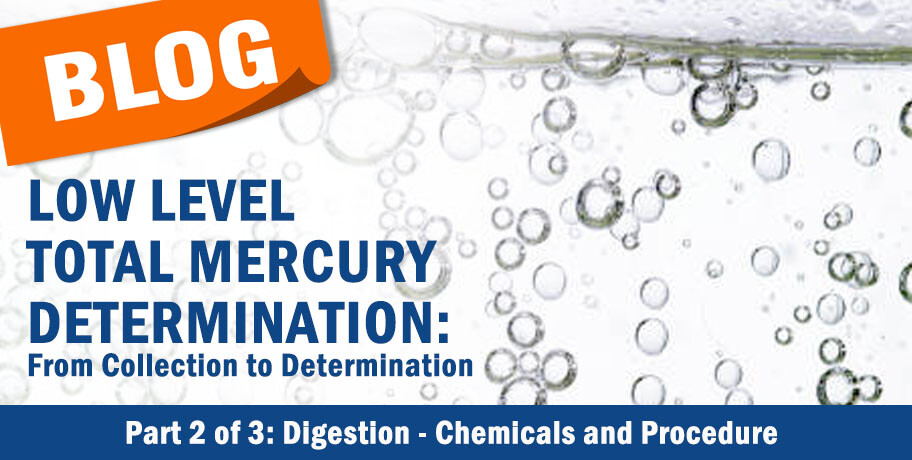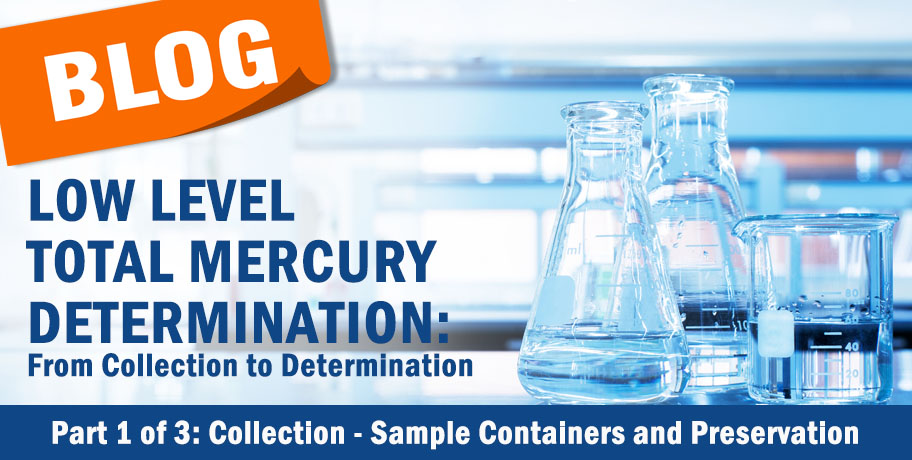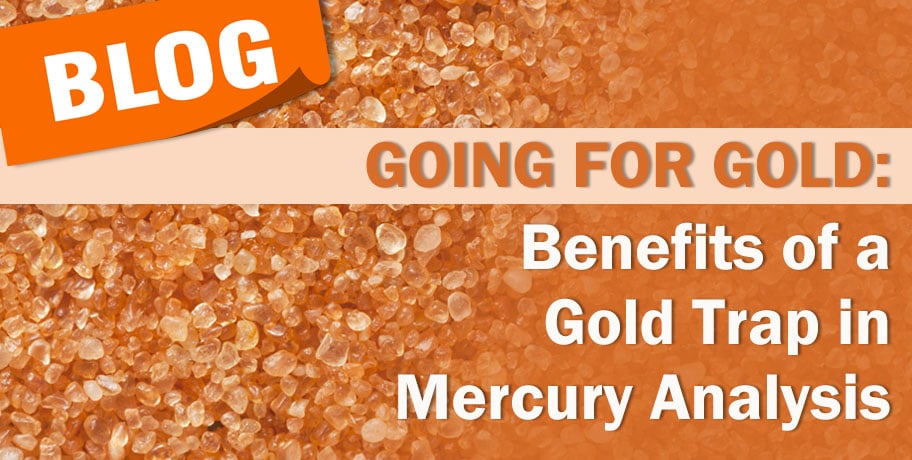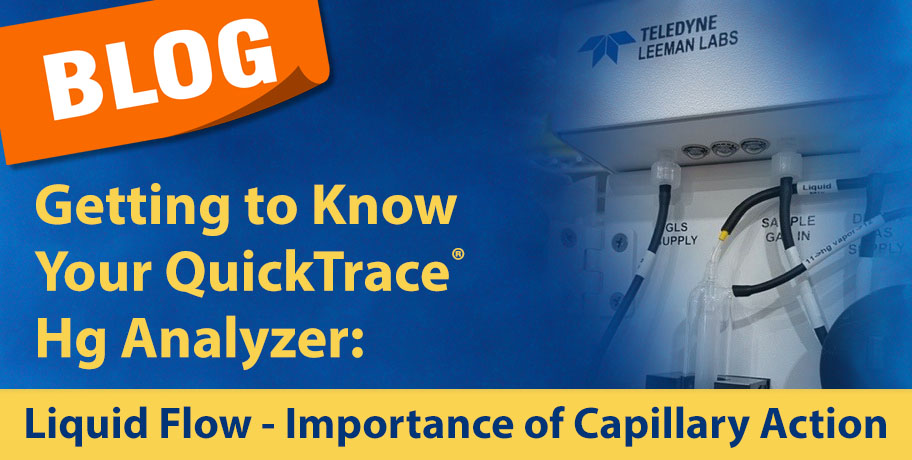Teledyne Leeman Labs has been in the mercury (Hg) analysis business for more than 30 years. We have had a variety of product lines reach new markets and address tighter regulations. In that time, one thing has remained constant across all our instruments: the need for accurate mercury standards to form the building blocks of the calibration curve. Analytical results are only as reliable as the calibration curve to which they are compared, and creating stable mercury standards comes with unique challenges.
Read MoreTeledyne Leeman Labs Blog
Mercury Stability in Hydrochloric Acid vs. Nitric Acid
Posted by Sara Kennedy on Jan 5, 2024 1:51:10 PM
Tags: Teledyne Leeman Labs, Hg analysis, mercury, mercury analysis, QuickTrace, hg
Low-Level Total Mercury Determination: From Collection to Determination: Part 2 - Digestion: Chemicals and Procedure
Posted by Sara Kennedy on Aug 4, 2023 1:39:39 PM
In Part 1 of this series, sample collection, container types, and preservation techniques for low-level total mercury (Hg) analysis were discussed. In Part 2, I will highlight contamination sources from chemicals and the potential for analyte loss associated with digestion protocols.
Read MoreLow Level Total Mercury Determination: From Collection to Determination
Posted by Sara Kennedy on Jul 28, 2023 1:27:22 PM
Mercury (Hg) determination at the ultra-trace level is an essential part of environmental assessment and drinking water monitoring. But this type of analysis comes with distinct challenges.
Read MoreTags: Hg analysis, low level mercury, mercury, mercury analysis, Determination of Trace Elements
Going for the Gold: Benefits of a Gold Trap in Mercury Analysis
Posted by Aaron Keller on Jul 25, 2023 12:05:30 PM
The gold standard. Go for the gold. A gold medal.
Gold is highly prized for its beauty, as a measure of wealth, a jewelry mainstay and more. When it comes to the analysis of mercury, gold has a very particular value in obtaining data at the ultra-trace level.
Read MoreTags: Hg analysis, mercury analysis, QuickTrace, gold
Usefulness of a Direct Combustion Mercury Analyzer
Posted by Jeff Forsberg on Jun 29, 2023 2:23:47 PM
Do you have a backlog of solids and/or semisolid samples you need to analyze for mercury determination? Or are you a teaching laboratory needing an instrument to complete that proposal you wrote? Or a laboratory exploring options to enhance your portfolio? Well, I encourage you to look to Teledyne Leeman Labs for viable options.
Read MoreTags: mercury, mercury analysis
Run it, don’t pollute it — filter your mercury exhaust
Posted by Aaron Keller on Jun 15, 2023 11:43:46 AM
Mercury poisoning is a serious concern for those of us who directly work with mercury. Mercury is a heavy metal with many adverse side effects for people and the environment, even in relatively small amounts. That is why mercury analyzers are useful for testing where health concerns exist; you likely use one in your own lab if you’re reading this.
Read MoreTags: mercury, mercury analysis
Getting to Know Your QuickTrace® 7600 Hg Analyzer - Liquid flow: Pump Tubing (Part 3 of 3)
Posted by Aaron Keller on May 11, 2023 9:50:28 AM
This is the third in a three-part series on Getting to know your QuickTrace® — The effect of liquid flow.
To catch up on the other blogs in this series click the links below:
- Part one: Getting to Know your QuickTrace®: The Effect of Liquid Flow: Pump Rate
- Part two: Getting to Know Your QuickTrace® - The Effect of Liquid Flow: Importance of Capillary Action
Tags: mercury analysis, QuickTrace
Getting to Know Your QuickTrace® - The Effect of Liquid Flow: Importance of Capillary Action (Part 2 of 3)
Posted by Aaron Keller on May 2, 2023 3:58:24 PM
This is the second in a three-part series on the QuickTrace® .
Part one is linked here, “Getting to Know Your QuickTrace®: The Effect of Liquid Flow — Pump Rate"
The importance of the moment the liquid sample is introduced to the gas liquid separator (GLS) via the capillary cannot be understated. Read MoreTags: mercury analysis, QuickTrace
Getting to Know Your QuickTrace®: The Effect of Liquid Flow: Pump Rate (Part 1 of 3)
Posted by Aaron Keller on Apr 26, 2023 9:53:51 AM
There are always lots of factors when it comes to running any samples: concentrations present, liquid and gas flow rates, unit detection limits, to name a few. The liquid flow is highly important in the QuickTrace® M7600 and QuickTrace® M8000 due to the sample and reagents being introduced by the liquid flow. In this three-part series, we will focus on three major elements that can affect liquid flow: the pump rate, the capillary action, and the tubing.
Read MoreTags: mercury analysis, QuickTrace
A lot of focus is put on anthropogenic (human-caused) releases of mercury into the environment, but let’s take a closer look into a powerful, natural source of mercury: volcanoes! We’ll explore why volcanic eruptions can increase global mercury levels, how we measure mercury released from past major eruptions, and how those measurements inform our policies for the future. So, how does mercury move from fire to ice?
Read MoreTags: mercury, mercury analysis










